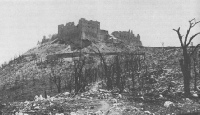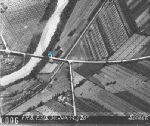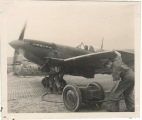



Whilst the Germans were on the run flak was negligible, however as soon as they became firmly established along the Gustav line, with the swollen river Sangro protecting them, the flak defences became most formidable. Chieti a nd Pescara were particularly heavily defended against air attack because of their importance to the enemy. By February 1944 the Germans appeared to have established an unassailable line of defences across Italy while the Allies were immobilised by the weather. The first few months of 1944 were frustrating for the Allies for the Anzio landings had failed to produce hoped for results and three attacks on the fortress at Cassino had failed to dislodge the hardened German paratroopers from their foxholes in the rubble of the Monastery. Our own troops on the east coast faced with the same grim determination were unable to advance any further and apparently no amount of aerial superiority could alter the situation.
nd Pescara were particularly heavily defended against air attack because of their importance to the enemy. By February 1944 the Germans appeared to have established an unassailable line of defences across Italy while the Allies were immobilised by the weather. The first few months of 1944 were frustrating for the Allies for the Anzio landings had failed to produce hoped for results and three attacks on the fortress at Cassino had failed to dislodge the hardened German paratroopers from their foxholes in the rubble of the Monastery. Our own troops on the east coast faced with the same grim determination were unable to advance any further and apparently no amount of aerial superiority could alter the situation.
To hinder the enemy from building up his supplies of food and ammunition the Mediterranean Allied Air Forces - of which the Desert Air Force was part - struck hard and regularly by day and by night at the German lines of communication in Italy.  This plan, known as Interdiction, involved bombing road and rail bridges as far north as the Alps, strafing trains and road convoys, bombing marshalling yards and supply dumps and attacking enemy airfields. The aim of this was to isolate the battlefield and starve the Germans of food and war equipment. 285 Wing provided the bomb damage assessment required to implement the carefully prepared interdiction plan. At the same time the fighter reconnaissance squadrons in the Wing were called upon to perform numerous tactical and artillery reconnaissance missions.
This plan, known as Interdiction, involved bombing road and rail bridges as far north as the Alps, strafing trains and road convoys, bombing marshalling yards and supply dumps and attacking enemy airfields. The aim of this was to isolate the battlefield and starve the Germans of food and war equipment. 285 Wing provided the bomb damage assessment required to implement the carefully prepared interdiction plan. At the same time the fighter reconnaissance squadrons in the Wing were called upon to perform numerous tactical and artillery reconnaissance missions.
Apart from obtaining valuable information for the Army, 40 (SAAF) Squadron was being called on to report over the R/T, during a mission, the existence of any possible targets for air attack. Once a suitable target was spotted its map reference was passed over the radio to the Mobile Operations Room Unit who scrambled the fighter bombers to the target. Once in the area the latter would contact the fighter reconnaissance section, locate the target and eliminate it.
for the Army, 40 (SAAF) Squadron was being called on to report over the R/T, during a mission, the existence of any possible targets for air attack. Once a suitable target was spotted its map reference was passed over the radio to the Mobile Operations Room Unit who scrambled the fighter bombers to the target. Once in the area the latter would contact the fighter reconnaissance section, locate the target and eliminate it.































